The double wide mobile home was a direct descendant of expandable mobile homes. The manufactured housing industry offered larger, more comfortable, and more luxurious models every year. A constant battle to come up with the latest concept or feature brewed between the builders. Just like a vehicle, people could trade their homes in for the newer model with all the fancy gadgetry so the newest concept meant big profits.
The 1950’s was a great decade for both mobile homes and automobiles. 1955 is even nicknamed ‘The Year of the Automobile’ by economist because one million more cars were sold in that year than the year before. Great engineering feats were made in both industries (except the Edsel but we’ll pretend that never happened).
In an effort to increase living space, the mobile home architects tried the 2 story mobile homes. However, they eventually realized that a 2 story mobile house was not the safest or easiest structure they could produce. It was simply ahead of its time.
Instead of going up they decided to focus in another direction.
Elmer Frey started the transition from 8′ wide home to 10′ wide. One could call him the grandfather of the double wide, especially since just about the entire industry was against him on it. Even the president of Spartan Trailers sent him a ‘not-so-nice’ letter stating his distaste for going wider instead of longer. He, along with many other presidents, thought going wider would be the worst thing to ever happen to the industry!
Within a year, after Frey had gotten many of the state highway departments to offer permits for 10′ wide mobile homes, they were all offering their own 10′ wide models.
DUBL-Wide by Roadliner
I happen to have an entire brochure about the DUBL-WIDE by Roadliner. Front to back, this pamphlet has always been one of my favorites.
The DUBL-Wide by Roadliner was a top of the line luxury home in the early 1960’s. It was the epitome of style and class. It also happened to be one of the first fully expandable mobile homes. A 9 ft. wide home could be expanded into an 18 ft. wide home.
This home used an electric crank system and could be moved while expanded. Think about that for a minute: an 18 foot wide home that could be moved without damage to the chassis. That’s amazing engineering!
Related: Vintage Views: Wingfoot Homes
Expandable Mobile Homes to Modern Day Double Wide
Expandable mobile homes were the first step toward the modern day double wides and triple wides. There were issues with the expandable systems whether hand-cranked or electric. The more parts you have the more chances of something going wrong. In this case, leaks were the biggest problem. The designers needed to simplify the designs to reduce hinges and crevices and moving parts. Eventually, they came up with what we know as the double wide mobile home. By separating and simplifying the original expandable mobile homes into two units and then combining those into a single unit on site they reduced the possibility of leaks.
Related: See Gorgeous Double Wides Here!
Summary: Expandable Mobile Homes
I find mobile home history to be fascinating. The progression of design fascinates me. They started so small and simple and they just kept going, each year was a better model than the last. It is a perfect example of American ingenuity!
Sources:
2 ads were found at Atlas Mobile Home Directory.

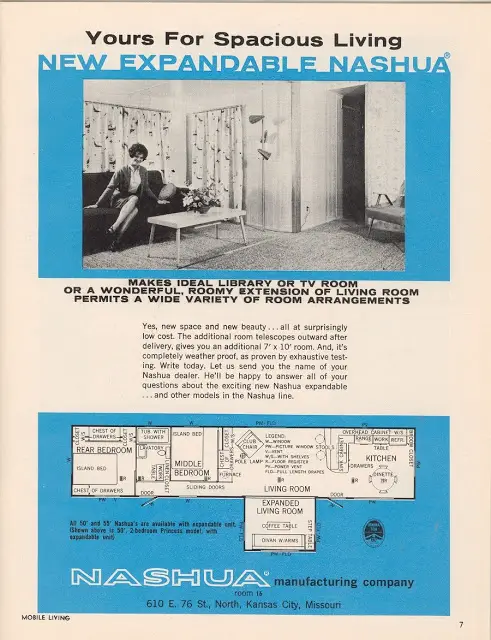


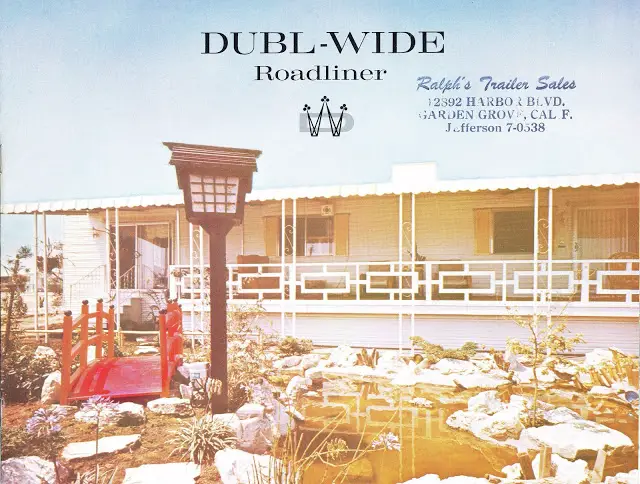

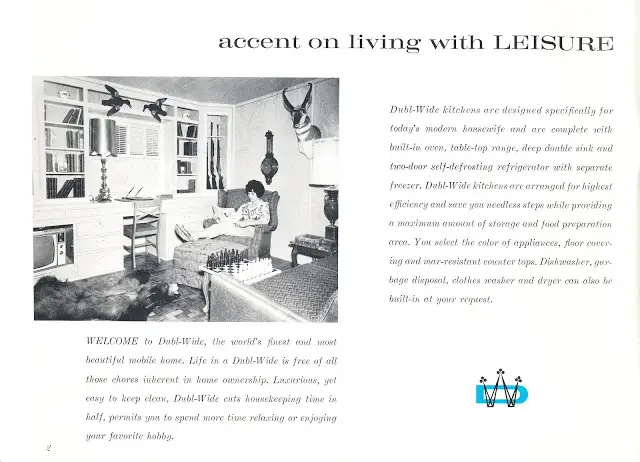
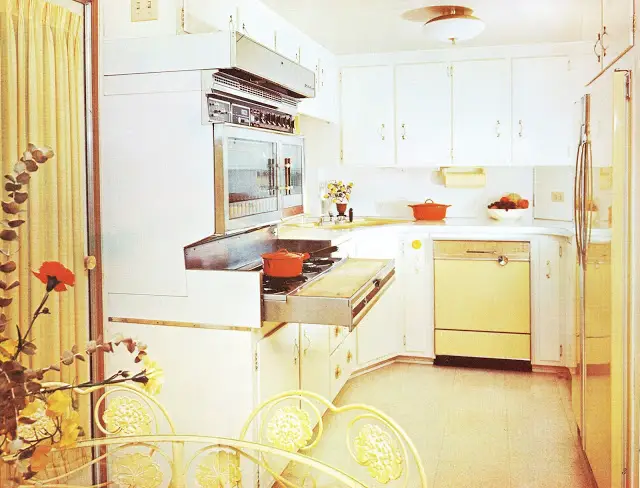

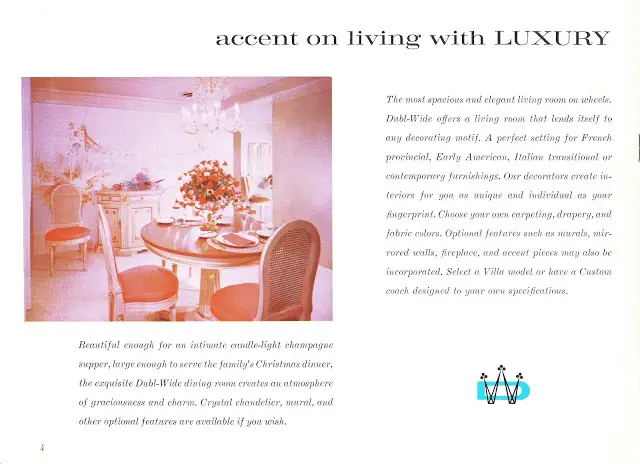

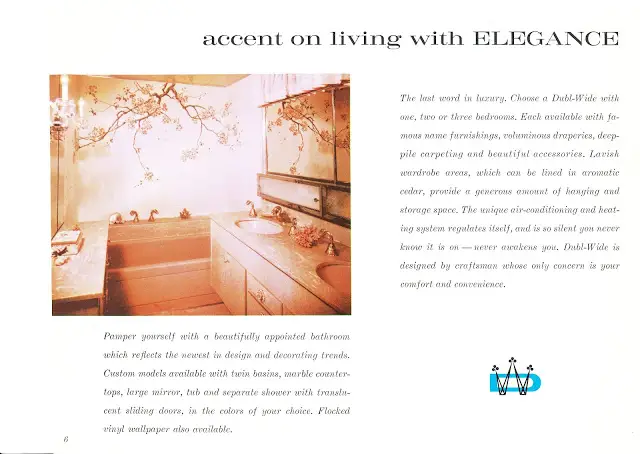

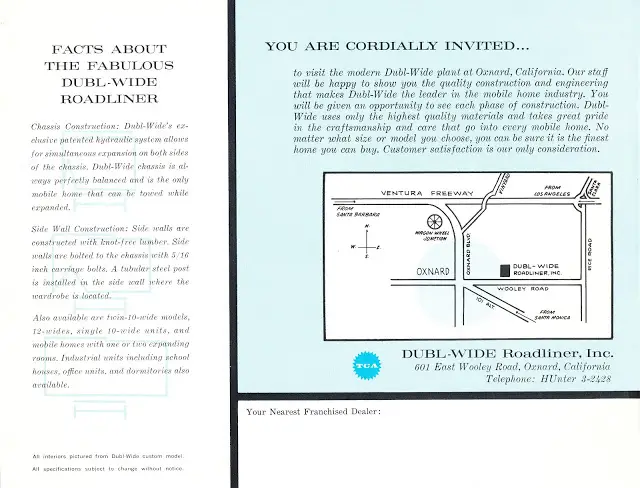


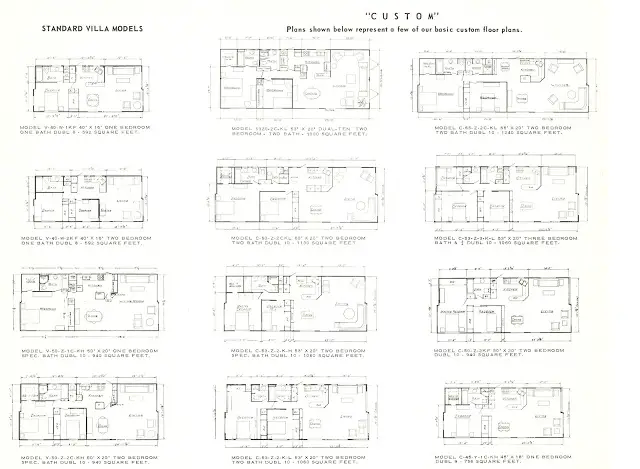
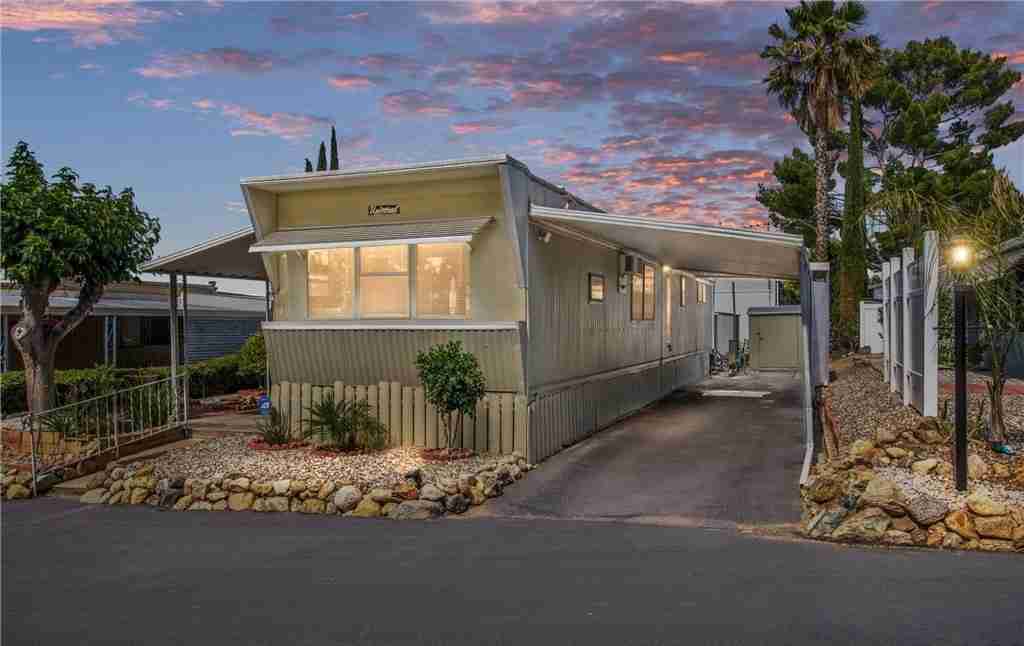
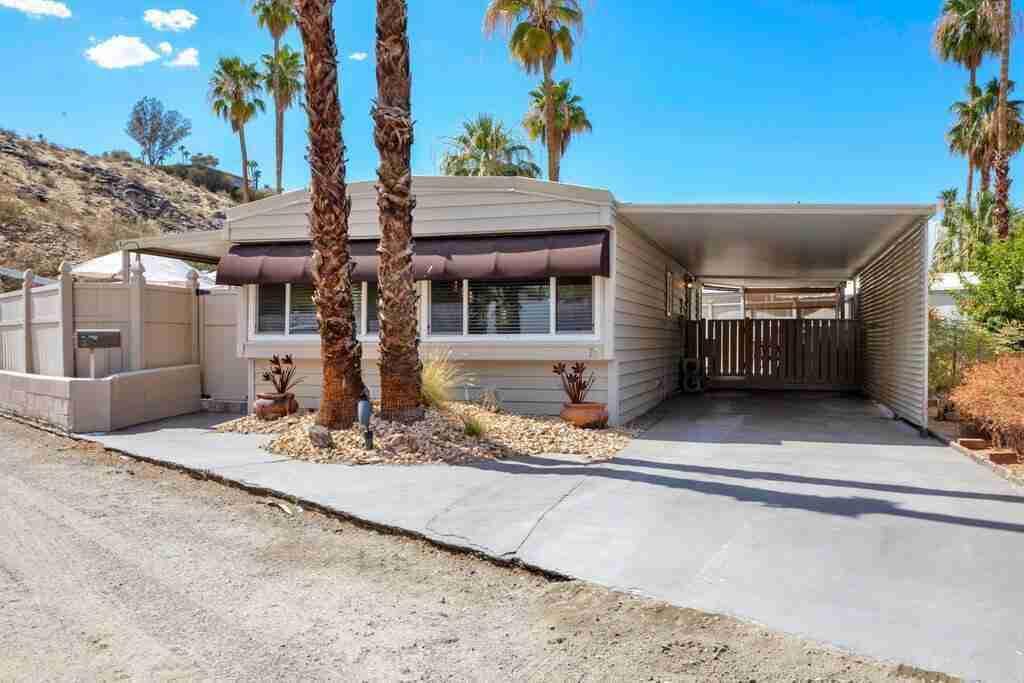

I just came across this link and information. I have a Magnolia Tri-fold from 63-65. I found the manufacturers plate by the front door but it is partially covered by an add on porch. The original mobile home developed roof leaks so a pitched roof was added. Ultimately, water got into the walls and the fold out plywood flooring rotted. I am looking to demo the house unless someone here comes forward for parts. Most windows are original crankouts, and the exterior metal siding is in good shape (white). The floor plan is 4 bedroom (2 in each crank out side) with kitchen, livingroom, hallway, and 2 bathrooms in the main section. The unit is located in Southeastern West Virginia
OMG I’ve been searching for years, based on your catalog I live in a C-45 (bottom right in the floorplan page), and I’ve always wondered how they folded up
Hi Leslie,
I would recommend you have the home’s piers inspected and make sure the home is level. If the home is level and the piers are healthy you should have no problem with standard materials. Best of luck!
I have a 1979 Squire with a 7 x 21 foot tip out. I have been trying to track down information about this mobile home for 3 years! What I’ve been told is that the manufacturing company was destroyed by either wind or fire at some point in time and was never rebuilt. I can find nothing on the internet about this company or these homes. My concern is that, as we remodel, all of the original stuff – built in buffets, vanities, kitchen cupboards, etc., were light weight, two sided constructions and are now being replaced with conventional and much heavier items. I’m concerned about the structure being able to handle the additional weight. The tip out, in particular, is bearing a lot more weight and can the hinge handle it. The floors are creaking and I’m having angst about the outriggers. And, then there’s the bow windows in which the original, lightweight aluminum windows, with no trim, have been replaced with conventional, single hung windows and trim, inside and out. So, if someone can help me with my fears, that would be great!!
Hi Mark,
Unfortunately, I have no information on Magnolia. Your best bet is to keep a lookout on Ebay and hope a collector will sell something (brochure, ad, etc). Other than books, that’s the only way I can find info on vintage mobile homes. Sorry!
Hi Crystal, I’ve been reading your posts on the Magnolia triple wides. What info do you have on them? I’ve been trying to find info, but so far no luck. We’ve got a ’63 triple wide, and since they’re such oddities, I’ve been trying to collect as much info as I can (photos, folding info, various floor plans etc). If you have any info you could share, it would be appreciated, or if you could direct me as to where to find info that would be great.
Thanks again,
Regards,
Mark
do you have photos of your folding magnolia? also, I’m curious how long yours is?
Thanks
Hi Selena,
On the tongue or the back of the steel chassis are the two most used areas. However, around the front door is another popular spot for many manufacturers. Hopefully, someone more familiar with Magnolias can help.
Best of luck!
I am looking for the serial # on my parents 1963 magnolia mobile home maybe a 10 x 50 in size. Can anyone direct me where to look for it.
Thanks
Selena
Hi Wendy,
Yes, several models were transported in a compacted form and then when it got to the site they would expand it out using hydraulics or cranks. It was a true engineering marvel!
I have a 1982 mobile home with an expandable on it trying to move it they took it completely off did it slide inside the mobile home cause it looked like it did the tor up the ceiling and floor doing this was there an easier way to live it
Hi Jason,
I’ve I’m not mistaken, they had 2 or 3 different systems that they tried over the years. You’d probably find more info on a vintage mobile home group on Facebook. Just join a few that seem most fitting and share a photo along with as much identifying information as possible and I can almost guarantee you will get some helpful information.
Best of luck!
Hi Magnolia fans I have a 1963 Magnolia.It is in beautiful shape Im blown away at how well it has been kept. I could use some more info on the cranking system. I found the cables and crank by the back door but im clueless as to how and where to connect them.
Sorry Anna, I do not have any information.
Hi,
Any chance you have information regarding a 1981 Fairmont Model 7014, specifically regarding them having the tip out option from the manufacturer? Company is out of Nappanee, IN and since they were bought out in 2014, I am unable to get much from them directly.
Any help would be appreciated!
I also just acquired a 1965 (I Believe) magnolia triple wide fold down trailer . however mine is not folded and I have considered folding it… How has your project worked out? I would like to restore mine if possible. but I am having a hard time finding the floor plan layout thanks for any assistance
Hi Leisha,
Congratulations! Town & Country was a popular brand back in the day.
The towing is dependent on a few things: your axle condition, tires, and the weight of the home are the biggest factors, not necessarily the size. When towing anything it’s the stopping that you need to be most concerned with, not the pulling. So, if the home is within your truck’s recommended towing capacity you’ll likely want to look into electronic braking and maybe even a transmission cooling system (basic towing accessories).
Salvage windows are pretty easy to find or special order from Lowe’s (windows are cheaper than most realize). The washer and dryer hookup may not be worth the cost. You’ll probably need to completely re-wire and re-plumb the home. In addition to the that you’ll have to account for the additional weight of the machine so that’s going to add difficulty to your towing (every pound matters when towing a lot of weight). Now, if you plan on putting the home in one place and leaving it there you’ll be OK with just a re-wire and re-plumbing.
Google RV forums or RV remodels and you’ll find several great blogs. Let me know how it goes! Best of luck!
Hi,
I was given a 40′ by 12’7” Town and Country that after a day of long research I find your site and i great lady from maufatured home that tells me it sounds like it’s from the 60’s or 70’s and back then the home where truly moblie and didn’t require no more than a good truck tractor to move them. It’s in NJ so I’m told just a wide load permit is needed to relocate it and my truck should be enough but you guys seem to know more so basically that’s my question. Can I move it with my 2500 8′ Dodge? Also from the floor it looks like it move in for easier towing? I do have great original cabinets and stove. The windows need some work so can anyone also please direct me how we can restore those on a budget. We have kids and it has a second small bunk room that looks like they removed the top bunk since the window is their but no bed. So I told my framer husband to enlarge the room and put the top bunk back plus a middle bunk at the foot of the two bunks for the my 3 little one. The bathroom has a tub/shower combo( the best thing about it) but I have seen a 5ther with washer/dryer connection in the bathroom combo too. I wanted to do that to my bath closet since I been good at keeping everyone to low linen supply a closet isn’t needed. Anyone knows how to do that or a site that will inform me on how to? The roof was change to those roll out roofs and the extra side that I hope moves has a small leek so any help on repairing that too. It’s not in the connected area it’s in the middle of that areas roof.
WOW! I loved reading this! The idea was good for the expandable homes but it was way ahead of its time. Thank you so much for taking the time to write all this out – It means a lot to me to be able to read first-hand accounts of how it really was!
Thank you, thank you!
We had a couple when I was growing up, a 1972, and a 1978.
When new, they came with 2 cranks that would lock onto the roof.
The cables would attach to the edge of the roof and two people would crank the roof up.
Now came the crazy part. A group of guys would lay the wall and floor section down.
You would need to have your floor supports ready and as close to level as possible.
Once supported, the “group” would lift the wall up and pivot the end walls and any room dividers out.
The roof would than be lowered onto the walls. The outside perimeter has tie down brackets all down the side that would have wing nuts to tighten everything up.
(I would get some of that double sided sticky insulation tape like used on a real house under the sill plates, before dropping the ceiling on the walls)
Spend the extra time making sure everything is level at this time !!
So many things can go wrong !! When we set these up, my dad usually had guys from the military base come and help. Lots of beer never helped !!
Only remember one guy going to the hospital when one of the hoist handles sprang back and hit a guy on the face….. Looked worse than it was luckily !!
My mom just moved out of the last trailer a few years ago. Told her to sell “as is” and claim no knowledge how to move it !!! I remember that we had stored the hoist under the trailer, can only imagine how rusty they might be after 30+ years?
Hi Scotty!
How exciting! 1973 was the start of the double wide craze so a triple wide was rare. I have not seen any specific information for the magnolia fold out except the one ad that tells about the honeycomb flooring and bead insulation. The 1950’s folding homes (which seems to be the inspiration for the ‘fold out mobile homes’) can be read about here: https://mobilehomeliving.org/fold-up-homes-of-the-1950s/
Best of luck and PLEASE take lots of photos of the process! I would love to see how it works and what it all looks like after you get settled in.
Hi all you Magnolia fans. Recently I acquired a 1973 Magnolia, triple wide. Now have it on some property, and ready to try my luck at folding it out. Any suggestions or advise would be greatly appreciated as I have yet to find anything printed other than the one small, very helpful set of photos on an earlier model flyer with the cables that appear to be lifting the roof, then possibly lowering the floor? Like most everyone else, I would sure love to find a manual, or set of instructions.
Hi Lindy,
It’s simply not possible in a lot of cases. Most tax departments and insurance companies understand this issue and will let you list the home as pre-1976. Before that year an information plaque wasn’t required so unless you get really lucky with the VIN number engraved on the tongues and frame or find the paperwork you simply won’t be able to find out for sure.
PS Magnolia Expandable homes were pretty cool!
How can I go about finding out what year model my mobile home is? We purchased it at a tax sale and have no idea what year it is. It’s a Magnolia expandable and we believe it’s from the 70’s but we need to know exactly what year.
Hi Ladonna,
I’ve been told that titles are not supposed to be used to prove ownership – only to prove that the owner paid the transportation tax and can legally transport the home/camper on the highway. Some states may use them as documented proof but in most instances they are only a Dept. of Motor Vehicle document and nothing more. In WV, a bill of sell or a property transfer document is used to prove ownership and all you need to do is apply for a new title (lost title application) on a mobile home or camper.
I’ve also read that insurance companies destroy titles when they pay a claim out and classify the home as unusable or unsafe for occupancy. It’s similar to car titles getting classified as salvage after a wreck has damaged the frame of the car.
The value of the home is going to be dependent on the upgrades made to it since your son got it. Besides hiring an appraiser, you can go to the NADA website and get a report created based on your answers to their questions. It costs around $20 and the website is:
https://www.nadaguides.com/Manufactured-Homes/Value-Reports/Online
The tax department may be trying to add the home as a site-built home instead of a mobile home. In many cases, you do not want this (if the home is still capable of being moved, lower taxes, etc.). In other cases, you do (equity building, insurance, etc.). Otherwise, they should be able to classify the home as a pre-1976 mobile home and that will have a base value or worth.
Each state is different and even each county handles things differently in the same state. That’s one of the negatives about mobile homes – there’s no across-the-board way to handle tax, installation, remodeling, and various other issues.
Best of luck!
My son has a Magnolia mobile home. Not sure of the year it was manufactured, late 1960s or 70s. He was given the home if he would take it down and move it approximately 4 years ago. He was able to move it and has since done a lot of remodeling and is now living in it.
The title to the home was destroyed by an insurance company when the previous owner had it. Not sure why. The tax office of our county is now wanting to put it on the tax rolls, but without a title they have no way of figuring the amount of taxes. He needs an idea of the selling price of the home when it was new. If anyone can help with this information we would greatly appreciated it.
Lynn, you’re my kinda lady!! I’m so glad to have you here; we need more true trailer gals in the world 🙂
I will certainly keep an eye out for anything I can find on Magnolia. I probably have an ad or 2, at least.
Thanks so much!
My parents bought a Magnolia expandable triple wide the summer of 1971 in Columbus, Ga. They later moved it to Columbia, SC in 1975 and then to Elgin, SC where it has been ever since. My brother lives in now. It has a very unique interior layout with the kitchen and 2 baths down the center and narrow 7′ bedrooms down both sides. The hall is very narrow too. The ceiling height at the sidewalls is only about 7′ but 9′ in the center of the living room. I would love to find a brochure and/or manual for it. I am a true trailer gal. Been living in them since I was born, a 30′ footer, unknown brand. Then a New Moon with a ‘tipout’ room in the mid 60’s. After I left home I bought my own Fleetwood in 1979. Owned it for 3 years. After living in apartments, a condo and a house I needed to get back on a rubber foundation. I moved into an RV in 1993 and have been in one ever since. A 30′ aluminum Avion since 2005. 44 years out of 54. Trailers forever! Lynn Dollarhide
I know I'm late on this post, but in 1977 we bought one of these folding mobiles made by Magnolia mobile homes. It looked like the first one posted here, but ours had bay windows and no sliding door over the tongue. It did have a fold down wood porch that covered the tongue. It folded out to about 30 feet. All the wet area's where down the middle. It came with harvest gold appliances, bath fixtures, carpet and curtains. Pretty cool huh? Heating and cooling bills were never above $30.00 a month. Those were the days. It would have been a great home only if the people that set it on our site knew what they were doing. They damaged the thing so bad. When the wind blew the dirt would come in so bad it would set off the smoke alarms. Ours was the only one that dealer sold as Magnolia took their dealer ship from them. I remember one thing I had to do was a yearly check of seeing if the wing nuts that held the home together where still tight. Years after we sold the home we helped some people take down one that was hit by a tornado (by the way the tornado took out all the stick homes too). I don't know what brand or year it was, but the interesting thing about it was the floor in the home. It was made from a thin layer of plywood, then a layer of about two inch cardboard in a honey comb shape then another thin layer of plywood. I guess that was to save weight.
Sandi
Thank for reading Tracy Ann!